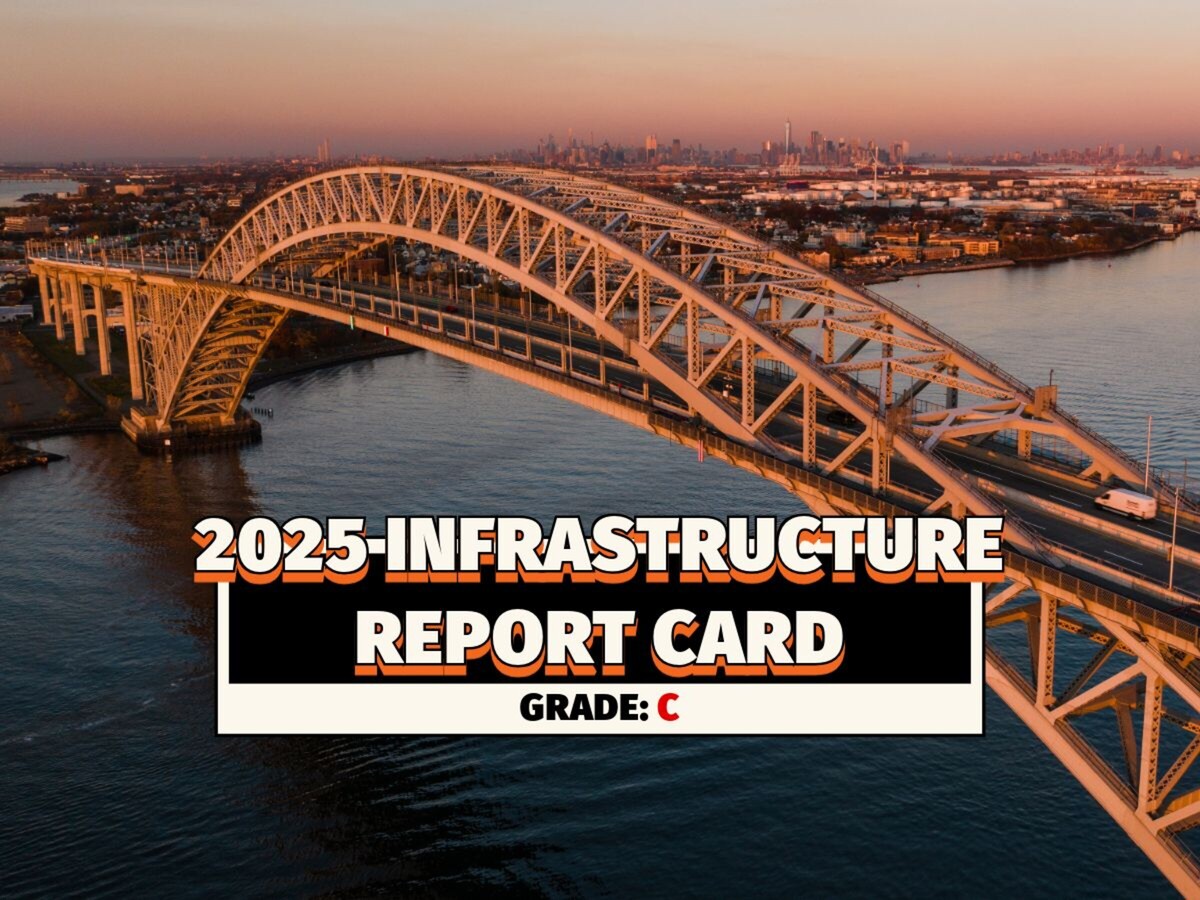Image


NEW JERSEY - The 2025 Infrastructure Report Card, released by the American Society of Civil Engineers (ASCE), assigns the United States an overall grade of C for the condition and performance of its infrastructure systems. While this represents modest progress from a C- in 2021, the new assessment underscores enduring challenges, including aging facilities, underfunding, and rising threats from extreme weather.
Eighteen major categories were evaluated, with ports receiving the highest mark at B, and stormwater and transit falling to the bottom with D grades. Notably, this is the first time since 1998 that no infrastructure category received a D- or F, a signal that federal and state investments—especially under the 2021 Infrastructure Investment and Jobs Act (IIJA)—are beginning to reverse decades of neglect.
Despite these improvements, the U.S. still faces a $3.7 trillion investment gap over the next decade to bring all infrastructure systems to a state of good repair. Without sustained action, economic losses from outdated infrastructure could surpass $5 trillion in GDP over the next 20 years, according to ASCE projections.
The Report Card grades reflect mixed performance across the infrastructure spectrum:
Top Grades:
Mid-Range Grades:
Lowest Grades:
 The 2025 grades range from a B in ports to a D in stormwater and transit. For the first time since 1998, no Report Card categories were rated D−. Among the 18 categories assessed, eight saw grade increases.
The 2025 grades range from a B in ports to a D in stormwater and transit. For the first time since 1998, no Report Card categories were rated D−. Among the 18 categories assessed, eight saw grade increases.ASCE attributes much of the nation’s infrastructure shortcomings to prolonged underinvestment. For decades, infrastructure funding failed to keep pace with economic growth, population expansion, and evolving technological and climate demands.
The 2021 IIJA and the Inflation Reduction Act (IRA) injected more than $580 billion in new federal spending—supporting improvements in roads, bridges, water systems, and broadband—but the full benefits will take years to materialize. Many infrastructure projects require extensive timelines for planning, permitting, and construction.
Meanwhile, the average age of key infrastructure components continues to rise. For example, most of the nation’s 92,000 dams are more than 50 years old, and a growing number are classified as high hazard. Similarly, aging water and wastewater systems face increased strain from contaminants and rising service demands.
Infrastructure vulnerability to climate-driven disasters is a growing concern. In 2024 alone, the U.S. experienced 27 extreme weather events, causing $182 billion in damages and claiming 568 lives. Infrastructure systems—especially stormwater, levees, roads, and power lines—are increasingly susceptible to flooding, hurricanes, wildfires, and other hazards.
ASCE advocates for resilient infrastructure design, emphasizing that each dollar spent on resilience yields an average of $13 in post-disaster savings. Yet many infrastructure owners hesitate to adopt such measures due to cost uncertainties and lack of sustained funding assurances.
To raise the nation's infrastructure grade, ASCE outlines a three-pronged strategy:
While the United States earned a C on the 2025 Infrastructure Report Card issued by the American Society of Civil Engineers (ASCE), New Jersey’s infrastructure shows signs of significant distress, imposing financial burdens on residents and raising concerns about public safety, economic competitiveness, and long-term resilience.
Road conditions in New Jersey are placing a direct strain on households. Drivers spend an average of $713 annually due to vehicle repairs, fuel inefficiencies, and lost time resulting from roads in poor condition. The state’s roads are heavily traveled and subject to seasonal stresses, yet decades of underinvestment in maintenance and modernization have contributed to these rising costs.
Bridges, a critical component of New Jersey’s transportation network, are also in a precarious state. Roughly 7.8% of the state’s bridges are rated structurally deficient, meaning key elements of these structures are in poor condition. Although structurally deficient bridges are not necessarily unsafe for use, they are vulnerable to closures, load restrictions, and sudden deterioration, especially during extreme weather events.
The cost of restoring and modernizing New Jersey’s drinking water systems is estimated at $8.6 billion, reflecting the urgency to replace aging pipelines, improve treatment facilities, and remove legacy lead service lines. Aging infrastructure, combined with stricter environmental standards and climate-related stresses, poses risks to water reliability and safety.
The state also faces serious dam safety concerns. New Jersey is home to 229 dams classified as high-hazard potential, meaning failure of any of these dams could result in significant loss of life or property. Many of these structures were built decades ago and are now vulnerable due to outdated designs, poor maintenance, or proximity to growing populations downstream.
New Jersey’s more than 2,500 public schools serve approximately 1.3 million students, but the physical condition of these buildings varies widely. The state faces an estimated $1.58 billion capital expenditure gap in its K–12 school facilities. This shortfall reflects needs related to maintenance, modernization, and safety upgrades—including air quality improvements, lead remediation, and climate control systems. Outdated and overcrowded school buildings can impair student learning and health, particularly in communities lacking local resources to address facility needs. Nationwide, only 10% of total school funding is spent on facility costs, and New Jersey is not immune to this trend.
If federal infrastructure investments revert to pre-IIJA levels, American families could face $700 in additional annual costs due to inefficiencies, delays, and failures in essential services. Moreover, the nation risks falling behind in global competitiveness, especially as other economies continue to modernize their infrastructure systems.
While the 2025 Infrastructure Report Card shows early signs of progress, it also serves as a stark reminder that bold, coordinated action is needed to protect public health, foster economic prosperity, and build a system that can meet the challenges of the 21st century.